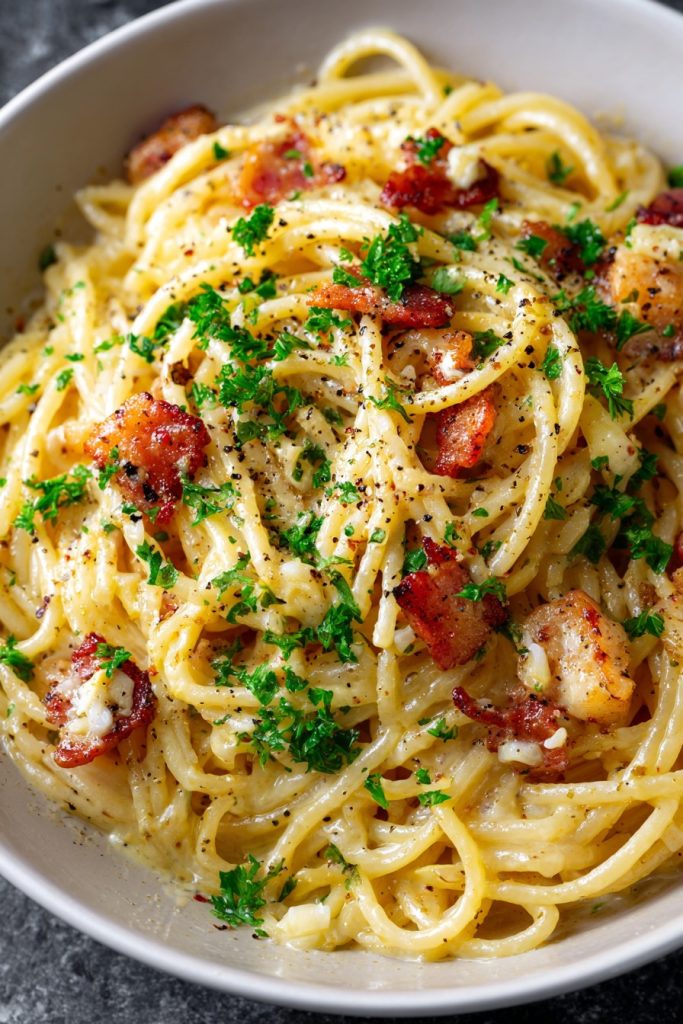Remembering those Sunday evenings when my grandmother would stand at her old cast iron stove, the air thick with the scent of frying pancetta and the promise of something magical. Really, it was more than just pasta—it was her way of wrapping our entire family in a warm embrace, of telling stories through food that connected generations. Returning to her carbonara recipe always brings back the sound of her laughter mingling with the sizzle of the pan, a symphony of love and tradition that I’m honored to share with you today.
Why This Recipe Works
- The combination of eggs and cheese creates that signature creamy sauce without any actual cream, staying true to the Roman tradition my grandmother learned from her Italian neighbors
- Using pancetta instead of bacon provides a more authentic, delicate pork flavor that doesn’t overwhelm the other ingredients, just like Nonna used to insist upon
- Cooking the pasta in well-salted water ensures it’s properly seasoned from the inside out, creating that perfect foundation for the rich sauce
- The technique of tempering the eggs with pasta water prevents scrambling while creating that luxurious, velvety texture that coats every strand
- Finishing with freshly cracked black pepper adds just the right amount of warmth and complexity, exactly how I remember it from childhood dinners
Ingredients
- 1 pound spaghetti
- 8 ounces pancetta, diced into ¼-inch pieces
- 4 large eggs, at room temperature
- 1 cup freshly grated Pecorino Romano cheese
- ½ cup freshly grated Parmigiano-Reggiano cheese
- 3 cloves garlic, minced
- 1 teaspoon freshly ground black pepper, plus more for serving
- 1 tablespoon kosher salt for pasta water
- 2 tablespoons extra virgin olive oil
- ¼ cup chopped fresh parsley for garnish
Equipment Needed
- Large pot for boiling pasta
- Large skillet or sauté pan
- Mixing bowls (one large, one medium)
- Whisk
- Tongs or pasta fork
- Measuring cups and spoons
- Grater for cheese
- Cutting board and knife
Instructions

Prepare Your Ingredients and Start the Pancetta
Before you begin cooking, take a moment to prepare all your ingredients—this mise en place approach reminds me of how my grandmother would meticulously arrange everything before starting, her hands moving with practiced grace. Place your large pot of water on the stove to boil, adding 1 tablespoon of kosher salt once bubbles begin to form. In your large skillet, heat 2 tablespoons of olive oil over medium heat until it shimmers, then add the diced pancetta. Cook the pancetta for 8-10 minutes, stirring occasionally, until it becomes crispy and golden brown around the edges and has rendered its fat. The aroma will transport you straight to those family kitchens of memory. Add the minced garlic during the last minute of cooking, stirring constantly until fragrant but not browned. Remove the skillet from heat but keep it nearby—you’ll need it warm for the final assembly.
Create the Creamy Egg and Cheese Mixture
While the pancetta cooks, turn your attention to the heart of the carbonara—the egg and cheese mixture that creates that magical creaminess. In a medium mixing bowl, whisk together 4 large eggs until they’re completely uniform in color and texture, just like watching my grandmother’s steady hand as she’d beat them with her worn wooden fork. Add both grated cheeses—the sharp Pecorino Romano and the nutty Parmigiano-Reggiano—along with 1 teaspoon of freshly ground black pepper. Continue whisking until everything is thoroughly combined into a thick, grainy paste. The key here is ensuring your eggs are at room temperature to prevent them from seizing when they meet the hot pasta. This careful preparation mirrors the patience my grandmother always demonstrated in her cooking, never rushing the process that would become our family’s comfort food.
Cook the Pasta to Perfect Al Dente
By now, your pasta water should be at a rolling boil—that vigorous bubbling that signals it’s ready to transform hard spaghetti into tender strands. Add 1 pound of spaghetti to the pot, gently pushing it down as it softens until fully submerged. Cook for exactly 8-9 minutes, stirring occasionally to prevent sticking, until the pasta is al dente—firm to the bite but cooked through. I always test a strand about a minute before the package directions suggest, remembering how my grandmother would pull one piece from the boiling water, blow on it gently, and taste it with a knowing nod. Before draining, reserve at least 1½ cups of the starchy pasta water—this liquid gold will be crucial for creating that silky sauce that makes carbonara so special.
Combine Everything While Hot
This is where the magic happens, the moment that transforms simple ingredients into something extraordinary. Working quickly, drain the pasta (except for that reserved water) and immediately add it to the warm skillet with the pancetta and garlic. Toss everything together thoroughly, allowing the residual heat to warm the pasta and distribute the pancetta evenly. Now, remove the skillet from any heat source entirely—this prevents the eggs from scrambling. Pour your egg and cheese mixture over the hot pasta, followed by about ½ cup of the reserved pasta water. Use tongs to toss and stir continuously, watching as the sauce emulsifies and coats every strand in a creamy, luxurious blanket.
Finish and Adjust the Sauce Consistency
As you toss the pasta, you’ll notice the sauce thickening and clinging to each strand. If it appears too thick or clumpy, add more reserved pasta water, 2 tablespoons at a time, until you achieve that perfect silky consistency that flows smoothly. The starch in the pasta water works wonders here, creating an emulsion that’s both light and rich simultaneously. Continue tossing for another minute off heat until the sauce reaches your desired texture. Taste and adjust seasoning if needed—sometimes I add an extra pinch of salt or another crack of black pepper, just like Grandma would do with that intuitive touch that came from decades of practice.
Serve Immediately with Final Touches
Carbonara waits for no one—it demands to be served immediately while still steaming hot, the way we’d all gather around the table the moment my grandmother called “pronto!” Divide the pasta among warm serving bowls, using tongs to create those beautiful nests of spaghetti. Garnish each portion with additional grated Parmigiano-Reggiano, another generous grind of black pepper, and a sprinkle of fresh parsley for that pop of color and freshness. The contrast between the creamy pasta, crispy pancetta, and sharp cheese creates a symphony of textures and flavors that will transport you straight back to those cherished family meals. Serve with crusty bread to soak up every last bit of sauce, continuing the tradition of leaving no delicious morsel behind.
Tips and Tricks
If you want to elevate your carbonara from good to extraordinary, there are several techniques I’ve learned over years of making this family recipe. First, consider using guanciale if you can find it—this cured pork cheek has a more complex flavor than pancetta and is actually the traditional Roman choice. My grandmother would sometimes splurge on it for special occasions, and the difference is noticeable in both texture and depth of flavor. When grating your cheese, always use the fine side of your grater rather than pre-grated varieties, which contain anti-caking agents that can prevent proper emulsification. The freshness matters tremendously here, just as it did in my grandmother’s kitchen where she’d grate cheese while telling stories about her own childhood meals.
Temperature control is absolutely crucial for carbonara success. Make sure your eggs are truly at room temperature by taking them out of the refrigerator at least 30 minutes before cooking. Cold eggs are much more likely to scramble when they hit the hot pasta, creating unpleasant curds rather than that smooth, creamy sauce we’re after. Another temperature tip: warm your serving bowls by rinsing them with hot water before plating. This small step keeps the carbonara at the perfect eating temperature longer, allowing you to savor each bite without rushing. My grandmother always insisted on warmed plates, saying that food deserved to be enjoyed properly from first bite to last.
If you’re concerned about the raw eggs in traditional carbonara, there are safe alternatives without sacrificing authenticity. You can gently temper the eggs by slowly whisking in a few tablespoons of the hot pasta water before adding them to the pasta, which raises their temperature gradually. Another option is to use pasteurized eggs, which have been heated to destroy potential bacteria while maintaining their cooking properties. For those who remain hesitant, you can create a similar creaminess by substituting one egg with ¼ cup of heavy cream, though my traditionalist grandmother would have raised an eyebrow at this modification. Whatever approach you choose, the key is maintaining that velvety texture that makes carbonara so comforting and memorable.
Recipe Variations
While traditional carbonara will always hold a special place in my heart, sometimes it’s fun to experiment with variations that still capture the spirit of the original. For a vegetarian version that maintains that satisfying umami quality, substitute the pancetta with sautéed mushrooms—cremini or shiitake work particularly well. Cook them until deeply browned and crispy-edged, then proceed with the recipe as written. The mushrooms provide a meaty texture and earthy flavor that surprisingly mimics the satisfaction of pancetta, creating a dish that would make even my carnivore grandfather nod in approval.
If you’re feeding a crowd or want to stretch the recipe economically, adding vegetables can bulk up the dish while introducing new flavors and textures. Peas are a classic addition—simply stir in 1 cup of frozen peas during the last minute of pasta cooking. For something more substantial, try roasted broccoli or asparagus tossed in at the end. My mother would sometimes add sautéed spinach when she needed to sneak more greens into our meals, wilting it into the pancetta drippings before adding the pasta. These additions maintain the creamy comfort while making the dish feel fresh and modern.
For those who enjoy different pasta shapes, carbonara adapts beautifully beyond spaghetti. Rigatoni or bucatini are excellent choices—their hollow centers or thicker structure catches more sauce in every bite. If you’re feeling adventurous, try making carbonara-filled ravioli or using the sauce as a base for a baked pasta casserole. My aunt would sometimes make “carbonara baked ziti” for family potlucks, combining the classic flavors with the convenience of a make-ahead dish. However you choose to modify it, the essence of carbonara—that magical combination of eggs, cheese, pork, and pepper—remains the comforting constant that connects us to generations of family cooks.
Frequently Asked Questions
Can I use bacon instead of pancetta in carbonara?
While you can technically use bacon, the result will be quite different from traditional carbonara. Pancetta is cured but not smoked, giving it a cleaner pork flavor that allows the other ingredients to shine through. Bacon introduces a smoky element that can overpower the delicate balance of eggs and cheese. If bacon is your only option, look for a lightly smoked variety and consider blanching it briefly in boiling water to remove some of the smokiness before dicing and frying. My grandmother always insisted that the quality of the pork made all the difference, saying that good carbonara should taste of the countryside, not the smokehouse.
Why did my carbonara sauce turn out scrambled instead of creamy?
Can I make carbonara ahead of time or reheat leftovers?
Carbonara is truly at its best when served immediately after preparation, as the sauce continues to thicken and can become gummy upon standing. However, if you have leftovers, the best approach is to gently reheat them in a skillet with a splash of water or milk over low heat, stirring constantly to redistribute the sauce. Avoid microwave reheating, which tends to make the eggs rubbery and separate the emulsion. For planning purposes, you can prepare components in advance—dice the pancetta, grate the cheese, and measure ingredients—but the actual assembly should happen just before serving to preserve that perfect creamy texture.
Is authentic carbonara really made without cream?
Yes, absolutely! Traditional Roman carbonara contains no cream whatsoever—the creamy sauce comes entirely from the emulsion of eggs, cheese, pasta water, and the fat rendered from the pork. The addition of cream is actually an American adaptation that changes both the flavor profile and texture significantly. While cream-based versions can be delicious in their own right, they lack the light yet rich quality that defines authentic carbonara. My grandmother would gently correct anyone who added cream to her recipe, explaining that the magic was in the technique, not additional ingredients.
Summary
This easy carbonara recipe captures the essence of family tradition through simple, quality ingredients and careful technique. The creamy egg and cheese sauce, crispy pancetta, and al dente pasta combine to create comfort food that connects generations. Serve immediately with extra cheese and pepper for a meal that feels like coming home.



